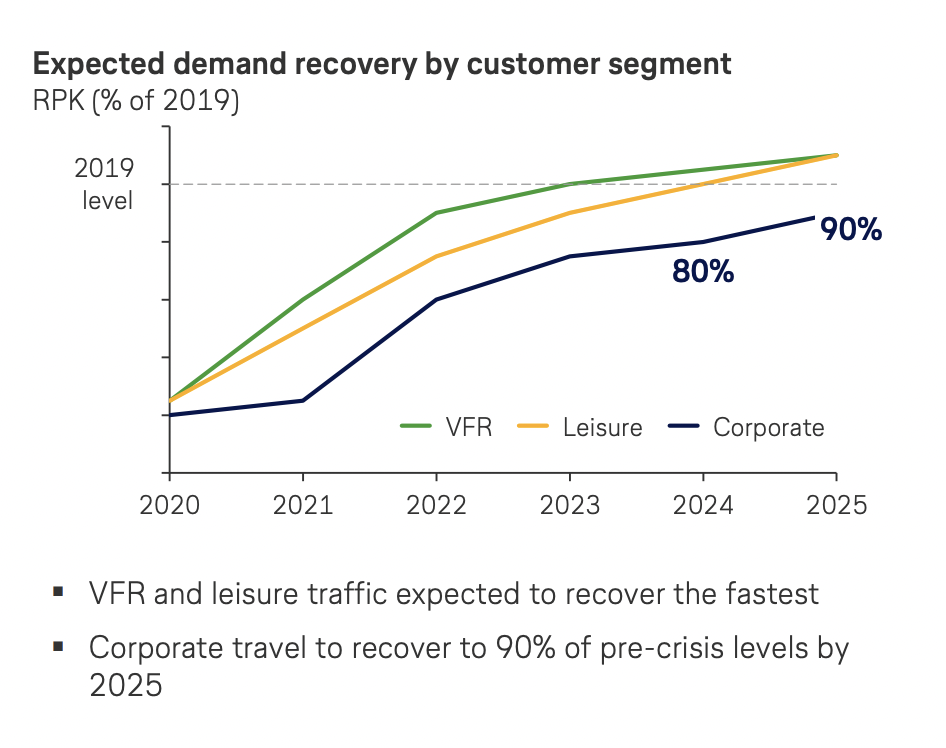Lufthansa Eyes Smaller Businesses For Corporate Travel Recovery

Photo Credit: Lufthansa expects business travelers to begin returning by the end of the year. Lufthansa / Alex Tino Friedel ATF Pictures
A big question in the executive suites of the world's airlines is: When and how will lucrative business travel return?
Estimates from both inside and outside the industry vary widely. From Bill Gates' statements that more than half of business travel will disappear as a result of the coronavirus pandemic, to United Airlines CEO Scott Kirby's seeming bullishness that corporate road warriors will come racing back to travel the minute they lose a sale over Zoom.
The Lufthansa Group is one airline group that is on the optimistic end of the spectrum. This is understandable, given that roughly 45 percent of its business is comprised of four passenger airlines — Austrian Airlines, Brussels Airlines, Lufthansa and Swiss — that rely heavily on business travel. Hence, it raised some eyebrows when group Chief Financial Officer Remco Steenbergen told financial analysts on Thursday that they anticipate "at least 90 percent" of corporate travelers returning by 2025.
"Small and medium [sized] companies who will need that positive experience of corporate travel to see their customers, to see their suppliers are making up a bigger share of our corporate customers," Lufthansa Group CEO Carsten Spohr said in response to analyst questions on Steenbergen's comments during a first quarter earnings call on Thursday. "That's the part I'm quite optimistic for.”
The group expects a spike in pent-up business travel demand by year-end, followed by a steady improvement to the 90 percent of 2019 levels through the middle of the decade. However, like its competitors, Lufthansa anticipates leisure and visiting, friends and relatives — or VFR — traffic to recover faster than its corporate segment.

Lufthansa has taken a number of steps to adapt to fewer lucrative business travelers flying. It has retired many of its long-haul jets with large business and first class cabins — including the Airbus A340 and A380, as well as the Boeing 747-400 — and it maintains the flexibility to replace some business class seats with premium economy seats on its Airbus A350s.
But the larger focus at Lufthansa is to become a more efficient group. This means continued staffing reductions, particularly in Germany, above the 24,000 full-time equivalent employees already removed since the Covid-19 crisis began. These reductions have helped Lufthansa reduce fixed costs by 35 percent.
And on the fleet side, the group has retired 115 aircraft on its way to removing 150 jets by the beginning of 2023. Lufthansa forecasts it can operate roughly 90 percent of 2019 capacity with just 80 percent of the planes — around 650 aircraft — on better utilization and denser seating layouts.
“We at Lufthansa have never been faster in restructuring and rightsizing the business in bringing down costs, variable and fixed cost in modernizing our fleet and in digitalizing our company," said Spohr.
Looking at this summer, Lufthansa sees the same pent-up leisure demand that other carriers do when governments ease Covid-19 travel restrictions. The group remains conservative for the second quarter, with plans to fly just 30-35 percent of 2019 capacity. However, it could ramp up capacity to as much as 70 percent of two years ago during the peak summer months of July and August if demand warrants, Spohr said. Full-year capacity is forecast at 40 percent of 2019.
In addition, the group is "encouraged" by the comments that the EU could reopen to vaccinated American travelers this summer, he added. The transatlantic market accounted for roughly half of Lufthansa's pre-crisis long-haul capacity.
Growing optimism for the summer does not mean Lufthansa is out of the woods. The group still expects cash burn of roughly €200 million ($242 million) per month in the second quarter after burning €242 million a month in the first. Asked when the group achieve breakeven cash flow, Steenbergen spoke of 2022 when the group is expected to fly more than half of its 2019 capacity.
In the first quarter, the Lufthansa Group's net loss was €1.05 billion. Revenues were down 60 percent versus 2020 to €2.6 billion on a 51 percent drop in expenses to nearly €4 billion. Passenger traffic fell 84 percent and passenger capacity 74 percent.
One bright spot was the group's budget arm, Eurowings. The carrier shrank its pre-tax loss by nearly 18 percent to €144 million year-over-year, whereas the loss at the group's network brands jumped nearly 42 percent. Unlike its network peers, Eurowings benefits from a customer base almost entirely made up of the leisure travelers who are returning to the skies. The airline has ambitious plans to expand beyond its traditional German focus to become a "pan-European" low-cost carrier, as CEO Jens Bischof put it in March.
Lufthansa Cargo and Technik were two other bright spots during the quarter. Both business segments posted a jump in income before taxes to €314 million and €16 million, respectively.
